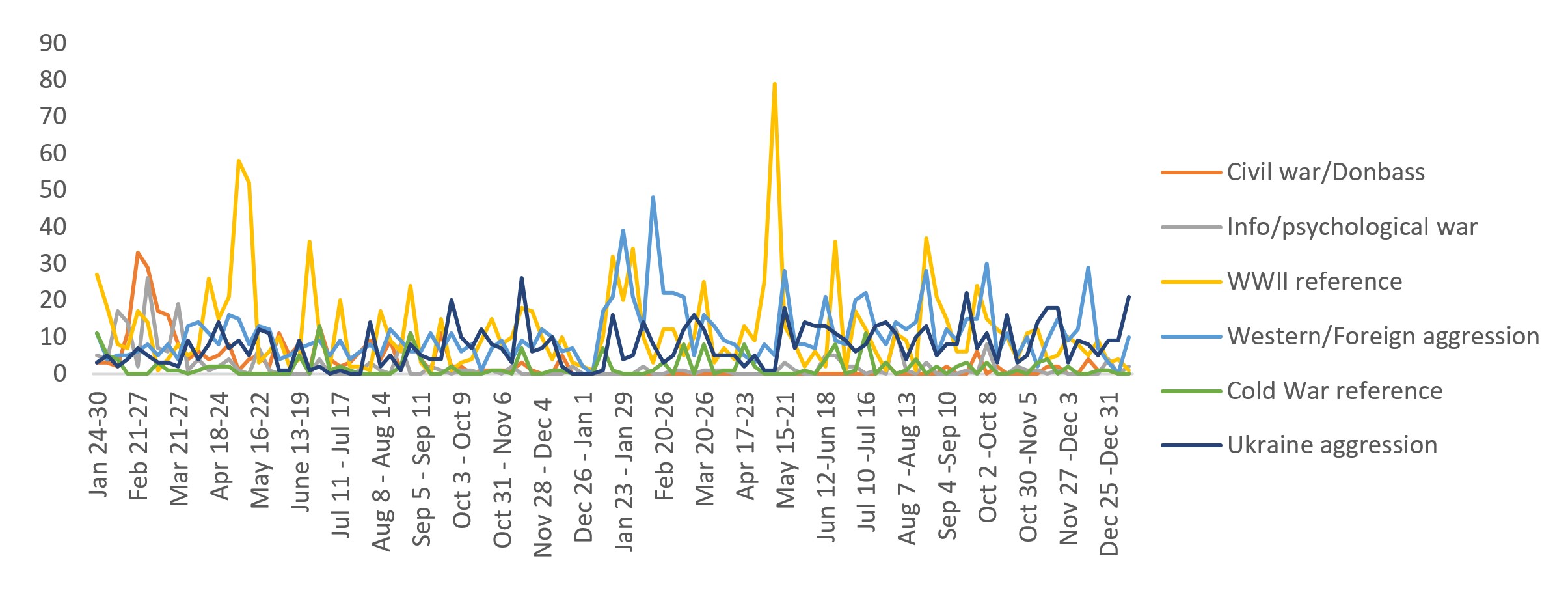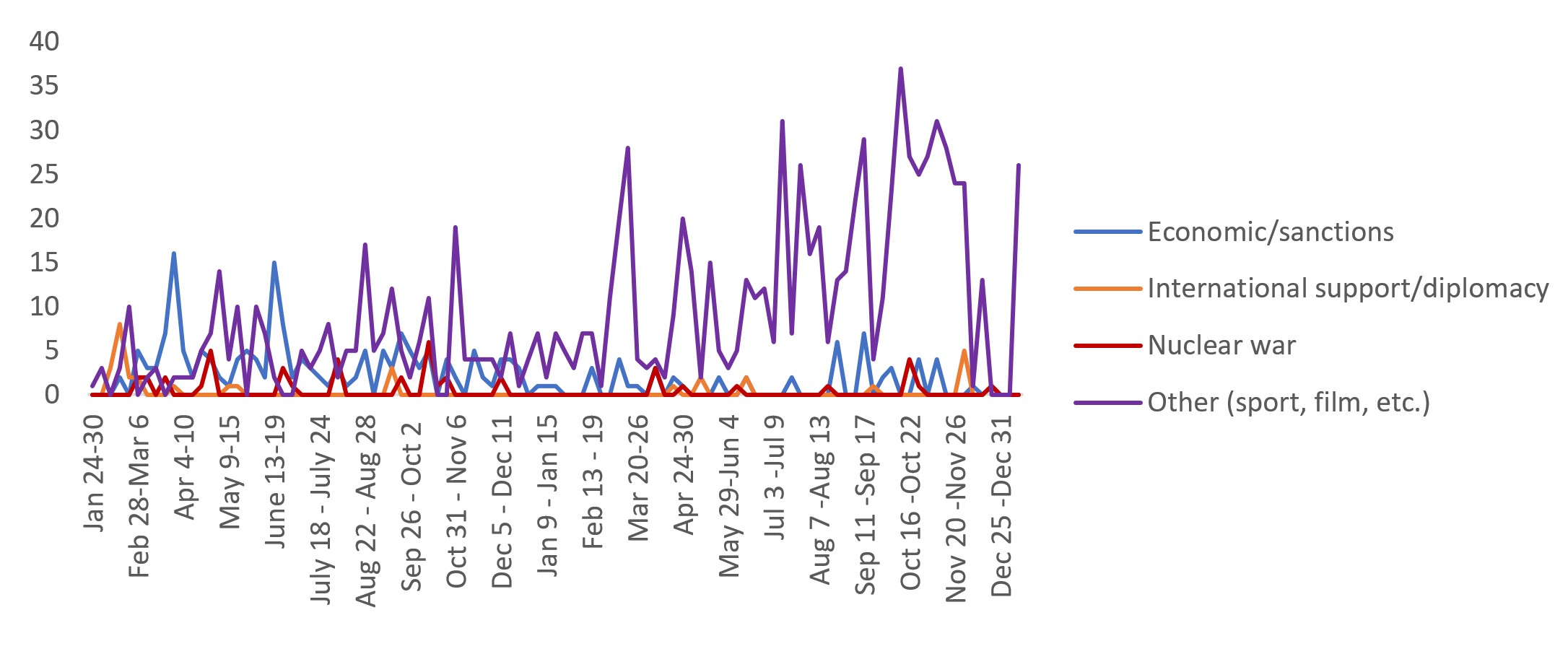RuMORs of War? TV and Russia’s War on Ukraine: Year 2
Last edited: February 13, 2024
Paul Goode, McMillan Chair of Russian Studies, Carleton University
Diana Danilevskaia, Research Assistant
Introduction
While the rest of the world understands that Russia has been waging war on Ukraine, its full-scale invasion is carefully presented as a “Special Military Operation” (SMO) in Russia’s domestic media. The evolving narratives about war in Russian television’s coverage of the invasion of Ukraine offer a revealing glimpse into the Kremlin’s strategy of information warfare and the manipulation of public opinion. This analysis is based on daily transcripts from the state-run television channel Pervyi Kanal, gathered using the Integrum database of Russian media. The findings highlight the rapid shifts in the narratives surrounding Russia’s involvement in the conflict, and these changes are often presented in a somewhat disorganized manner.
The most prominent narrative in the coverage is the recurrent use of “war” in the context of World War II and Western aggression. This prevalent narrative reflects the deliberate framing of the war in Ukraine in a historical context and as a struggle against Western forces, providing insights into the messaging strategies employed by Kremlin.
Methodology
The findings are drawn from a qualitative content analysis on the usage of the term “war” in Russian television, with a focus on the state-run Pervyi Kanal. Pervyi Kanal was selected as the state-run channel is a key source of official narratives from which other broadcast and social media take their cues. Daily broadcasts were coded for references to different varieties of war mentioned on television since the start of the full-scale invasion in February 2022, including: Civil war (with regard to Donbas), information or psychological warfare (usually with reference to the West), the Great Patriotic War (or Second World War), the Cold War, economic war (sanctions), the threat of nuclear war, as well as allegations of Western or foreign-sponsored aggression and aggression by Ukraine. Mentions of war in unrelated contexts, such as in sports or film, were also catalogued. Reports were coded based on the immediate context in which the term “war” was used or, when unclear, the broader meaning associated with the report.
Conflicting Narratives
The analysis unearthed a profound disparity in the narratives related to the war in Ukraine. In everyday life, the official euphemism of SMO has become an informal means of signalling or identifying one’s loyalty to Putin’s regime. While it is an open secret that Russia is at war in Ukraine, mentions of “war” remain politically sensitive. Consequently, the ways that state-run television discusses “war” is revealing of the ways that the Kremlin seeks to frame its invasion.
The most prevalent narrative centered around references to the Great Patriotic War, which has been a staple of domestic propaganda over the last decade. This narrative aims to unify the Russian populace and stoke patriotic fervor and is clearly linked to the officially proclaimed goal of Russia’s invasion as “de-nazifying” Ukraine. References to the GPW evoke a sense of the inevitability of Russia’s victory over fascism as commemorations of the GPW are fused with the present day. As a result, it mentions of the GPW often overshadow contemporary military events in Ukraine, especially during significant historical anniversaries.
While Russia is not depicted as waging war in Ukraine, the West is repeatedly accused of provoking or waging a proxy war in Ukraine—the implication being that Russia is not at war with Ukraine, but its actions are necessary to defend it from the West. The most common accusations include sponsoring and training Ukrainian soldiers, non-compliance with NATO agreements, and otherwise pursuing strategic goals against Russia. Notably repeated were Putin’s claims that Western politicians would fight Russia “to the last Ukrainian,” thereby intensifying anti-Western sentiments.
Direct references to a Civil War in Donbas and Ukrainian aggression were surprisingly infrequent, especially given Russia’s fraudulent claim to be intervening to halt a purported genocide of ethnic Russians. While claims of Ukrainian aggression did experience a slight uptick from October 2022 onwards—coinciding with Russia’s mobilization efforts—it remained secondary to the portrayal of the West as the primary antagonist. In this fashion, Russian propaganda deprives Ukraine of agency and depicts it as a pawn of the West. Notably, in 2022, the primary focus of accusations regarding Ukrainian aggression honed in on civilian-humanitarian matters. Specific claims pointed to Ukrainian nationalists shelling civilian cities extensively, constituting a clear violation of the laws of war. In parallel, Russian news reports conveyed that millions of people in the DNR, LNR, Zaporizhzhia, and Kherson regions voted for a peaceful life, standing against shelling and bullying perpetuated by nationalists. Consequently, the first year of the conflict saw comprehensive coverage of violations, thrusting the human rights situation in Ukraine into the international spotlight.
Figure 1: Total Uses of “War” on Russian TV, February 2022 – January 2024 (mentions per week)

During the second year of the war, there was an overall increase in mentions of Ukraine’s aggression on Russian TV channels. Accusations against Ukraine and President Zelenskyy gained momentum in 2023, transitioning from humanitarian concerns to more politically-charged criticisms. Media coverage expanded to encompass Kyiv’s actions against Hungary’s largest bank, operating in Russia. Also, allegations surfaced, suggesting that the persistence of the war was influenced by President Zelenskyy’s insistence, a sentiment echoed by Zelenskyy’s adviser, Mykhailo Podolyak, who outlined conditions for Ukraine’s self-preservation. These conditions emphasized the necessity for resources and weapons. Simultaneously, reports covered mobilization efforts in Ukraine, coinciding with a significant mass exodus of conscripts abroad.
Collectively, these mentions underscore a slight shift in Russian media’s narrative. While still highlighting the negative outcomes allegedly brought about by Ukraine, there is now an inclusion of reasons, attributing responsibility to its government. In line with the attribution of war to foreign aggression, it has also been discussed with reference to risks and impacts. Over time, “war” has come to be associated less with the tangible effects on the economy, sanctions, or the threat of nuclear conflict. Instead, it has increasingly been linked to cultural production and sports.
Sanctions as economic warfare and its negative impacts on Russia was a prominent narrative early in the war. However, it is important to note that Western sanctions are contextualized as a continuation of the sanctions regime imposed on Russia since 2014 and not as a response to the full-scale invasion of 2022. Indeed, much of the reporting on sanctions concerns their lack of impact on Russia’s economy, the success of Russia’s import-substitution strategy, their lack of international support, evidence of sanctions backfiring or fatigue, and the resilience of Russians in overcoming Western sanctions. A second narrative that was prominent early in the war concerned the potential for nuclear war with the West, which similarly emphasized Russia’s strength and its ability to face adversaries. However, neither of these narratives currently holds a prominent place on Russian television.
Regarding “other” references, the figures experienced fluctuations but notably surged starting July 2023, with the most substantial uptick in mentions of the Israeli–Palestinian conflict observed from October 2023 onward. Throughout the initial eighteen months of the conflict, these references were predominantly tied to the unveiling of new war-themed films labeled as “based on historical facts,” national holidays, concerts, and other performances, such as presentations of War and Peace in neighboring countries and premieres of ballets by Donbass Opera artists at the Bolshoi Theater in Moscow. Additionally, mentions included commemorations of birthdays and deaths of individuals who participated in World War II, commonly referred to as “Soviet heroes” in Russian media. Some references were also made to the U.S. Civil War and its historical approach to warfare against other nations, although Ukraine was not explicitly mentioned in the same context.
Figure 2: The War on Russian TV: Implications, February 2022 – January 2024 (mentions per week)

Conclusion
The relative absence of Ukrainian narratives on Russian television reflects a multifaceted approach by the Russian government in its information warfare strategy. This approach can be understood in several ways:
- Obscuring Negative Associations. The lack of explicit references to “war” suggests an effort to downplay the negative aspects of the war in Ukraine, particularly its economic and human costs. By reserving mentions of war for other contexts such as the GPW or Western aggression, the Kremlin frames perceptions of the actual war in Ukraine and its associated consequences. In doing so, the government aims to maintain public morale and reduce concerns about the conflict’s economic and humanitarian impacts while also establishing the boundaries of permissible speech within Russia.
- Diverting Public Attention. Another interpretation is that the government is using this absence to divert public attention. On the one hand, it emphasizes more neutral or less contentious topics to shift focus away from the war while keeping the public engaged. On the other, it normalizes war talk alongside the perception that Russia is encircled by a hostile West. This media priming can help to maintain control over public discourse and shape public opinion through the media, potentially manifesting via “rally around the flag” effects, “third person” effects, and “spirals of silence.”
- Information Strategy and Vision. The absence of explicit references to war in Ukraine also conceals the lack of a well-defined strategy or a clear vision for the war’s objectives and outcomes. For example, Putin’s original public rationale of invading to “denazify” and “demilitarize” Ukraine ceased to be mentioned long ago. Its absence in media discourse further sidesteps questions about whether the Russian state apparatus has a comprehensive, long-term plan (other than trusting Putin) or if it is merely reacting to changing circumstances that it no longer controls. The carefully cultivated media silence around “war” and its consequences were clearly evident in the panic surrounding Evgeny Prigozhin’s brief mutiny, in which the evolving and inconsistent use of narratives in Russian television coverage underscored the complexity of propaganda and information warfare in a rapidly changing geopolitical context.
In this light, it is significant the uses of “war” on Russian television portray events since February 2022 as a continuation of the past decade of relations with Ukraine and the West. This tendency dovetails more generally with the normalization of war for viewers of Russian television.